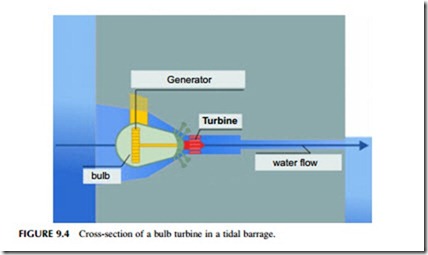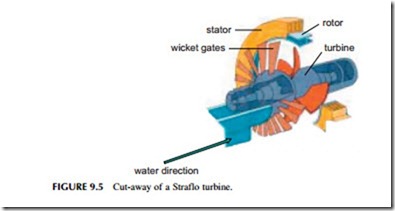TURBINES
The turbines in a tidal power station must operate under a variable, low head of water. The highest global tidal reach, in the Bay of Fundy in Canada, is 15.8 m and the mean tidal reach probably half of this range; most plants would have to operate with much lower heads than this. Such low heads necessitate the use of a propeller turbine, the turbine type best suited for low-head operation. The fact that the head varies appreciably during the tidal cycle means that a fixed-blade turbine will not be operating under its most efficient conditions during the majority of the tidal flow; consequently, a variable-blade Kaplan turbine is usually employed. As is the case with most low-head hydropower plants, tidal power plants usually employ a series of small turbines running along the barrage since these can exploit the available energy more effectively than a small number of large turbines.
The most compact and efficient design of propeller turbine for low-head applications is the bulb turbine in which the generator attached to the turbine shaft is housed in a watertight pod, or bulb, directly behind the turbine runner (Figure 9.4). The whole turbine–generator assembly is then hung inside a chamber that channels the water flow through the turbine blades to extract the maximum energy possible. The La Rance tidal plant employs 24 bulb turbines, each fitted with a Kaplan runner and a 10 MW generator. Bulb turbines were new when La Rance was built and construction of the plant involved some experimental work; of the 24 turbines, 12 had steel runners and 12 had aluminum bronze runners. Experience has led the operators to prefer the steel variety.
The turbines at La Rance were designed to pump water from the sea into the reservoir behind the barrage at high tide to increase efficiency. This was found to cause severe strain on parts of the generator and the design had to be mod- ified. Work was carried out between 1975 and 1982. Since then the plant has operated smoothly and with high availability.
The more recent Sihwa tidal plant in South Korea also uses bulb turbines. In this case the plant is equipped with ten 26 MW bulb turbines with variable- blade propeller units. This power plant is built into a sea wall erected in 1994 to create an inland lagoon where water was collected for irrigation. Since
then industrial pollution of the lagoon has made the water unusable. The tidal plant forms part of a scheme intended to flush the lagoon to reduce pollution levels. Unlike most other tidal barrage plants, it generates on the flow tide.
An alternative to the bulb turbine is a design called the Straflo turbine (Figure 9.5). This is unique in that the generator is built into the rim of the turbine runner, allowing the unit to operate in low-head conditions while keeping most of the generator components out of the water. A single large Straflo turbine generator was installed at the Annapolis tidal power plant at Annapolis Royal in the Bay of Fundy, Canada. This 18 MW unit is the only one of similar size that has been built, so experience with the design in limited.

